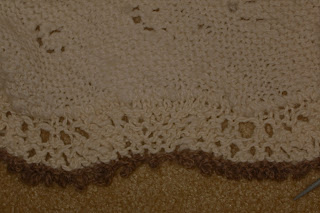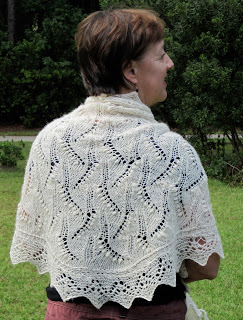About a year ago, I noticed in one of my LYS that Rowan was producing a line called "British Sheep Breeds." Coincidently, in the last three years or so, I am interested in the wool that come from specific breeds of sheep, and their qualities. This may be a result of starting to spin and produce my own yarn. I spin from roving that I purchase (no, I don't yet work from fleece, maybe that will happen when I retire and have put my two sons through college...and have lots of time).
Rowan has three products in their line:
DK Undyed which is Bluefaced Leicester
Chunky Boucle which is Bluefaced Leicester (available only in natural ecru)
Chunky Undyed in varying natural shades, including Bluefaced Leicester, Shetland, Black Welsh, Jacob, and Grey Suffolk
I have not used any of these, only fondled them! I am considering the BFL Chunky for my next
Rogue
However, I'm also interested in the local produce/products concept, and am very interested in less emphasis on production and more on sustainability.
I'm also interested in what might be considered somewhat less, uh, overproduced? Not that I don't like a Debbie Bliss purchase, and honestly, at this point, I still like knitting a sweater out of a commercially produced yarn from a carefully blended and produced fiber, that is a little more predictable than my handspun.
Issue 23 of
The Knitter features an article on Britain's sheep breeds entitled "The Return of the Native." Because the price of wool is so low, farmers cannot afford to maintain wool flocks for fiber, rather, they are focusing on meat production. Indeed, non wool bearing sheep breeds are being developed!!
To maintain the traditional wool breeds, Prince Charles launched the
Campaign for Wool this year. Ironically,
wool week is commencing as I write this (not planned)...wool week has many relevant activities in case you live in the UK or are lucky enough to be visiting this week!
The article has a shortlist of British sheep breeds, of which there are more than 60, as well as a list of producers of yarns made from these breeds. I don't know how many of these are raised in the US.
In my travels last year to Scotland, I encountered several of these breeds. I was lucky to travel in a very small plane to North Ronaldsay, the northernmost island in Orkney.
Here's the extremely small aircraft, with an ad for Highland single malt scotch (don't know which one, there are lots) on the side:
That is my dear friend Debbie from Ohio on the right. Here is a photo of our pilot, whose anterior view bore a very strong resemblance to Clooney. Naturally, we assumed that he was not partaking of Highland single malt or any other, single, blended, or otherwise, while reading the safety instructions (which he did with Clooney's grace and je ne sais quoi {well, I do but can't quite express it in English or French}) and subsequently while flying. Actually he was better than Clooney, as he had a lovely Scots (NOT Glaswegian) accent. (If you're from Glasgow, sorry about that...). That said, I wouldn't have minded meeting him in the bar while drinking some sort of something...perhaps single malt, which is a big stretch for me...I would even have put my bar knitting aside...
AT ANY RATE we flew to see the seaweed eating North Ronaldsay sheep where they live (Fair Isle was in the distance but you can't see it here):
I purchased North Ronaldsay roving and yarn while there, it's just buttery-soft, supposedly because of the seaweed?? No idea what to do with it (yet):
Pam Murray is the dyer. The natural color has the North Ronaldsay label. Amazingly, there is a mill right on this little island, which I hope to blog about in a later post.
I also spied Scottish Blackface sheep while on a bus tour through the Isle of Skye (I thought this was a pretty great photo if I may say so, myself):
Of course, Shetlands were in view in Shetland:
Speaking of Shetland, here's an update on my hap shawl, originally documented
here. I am currently spinning the yarn for this, and I have several shades of the natural Shetland so it will have the authentic stripe-y effect. I have finally finished the square with the exception of a couple of rows:
and am about to pick up stitches for the fan and feather edging. It's taken me several years to get this far. This is the only one in my "free patterns." Once the edge is done, I will update it. In the meantime, if you've tried this, keep track of the stitches at either side; I did not and had to make a wee correction!
Coming up soon...a post on bar knitting. My friend Jennie from Cheshire denies that it exists, and she would kill me if I did it in her company...
































